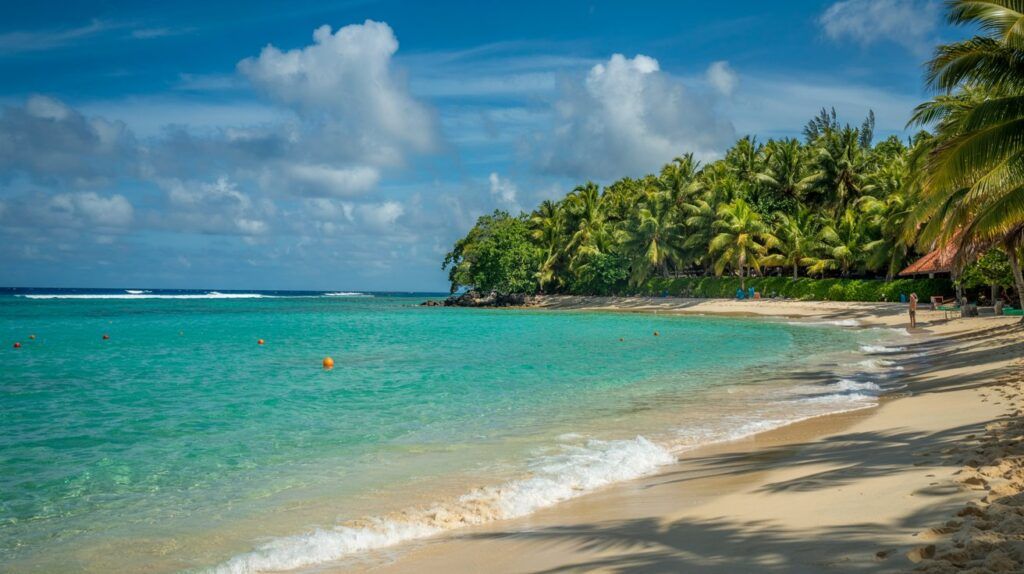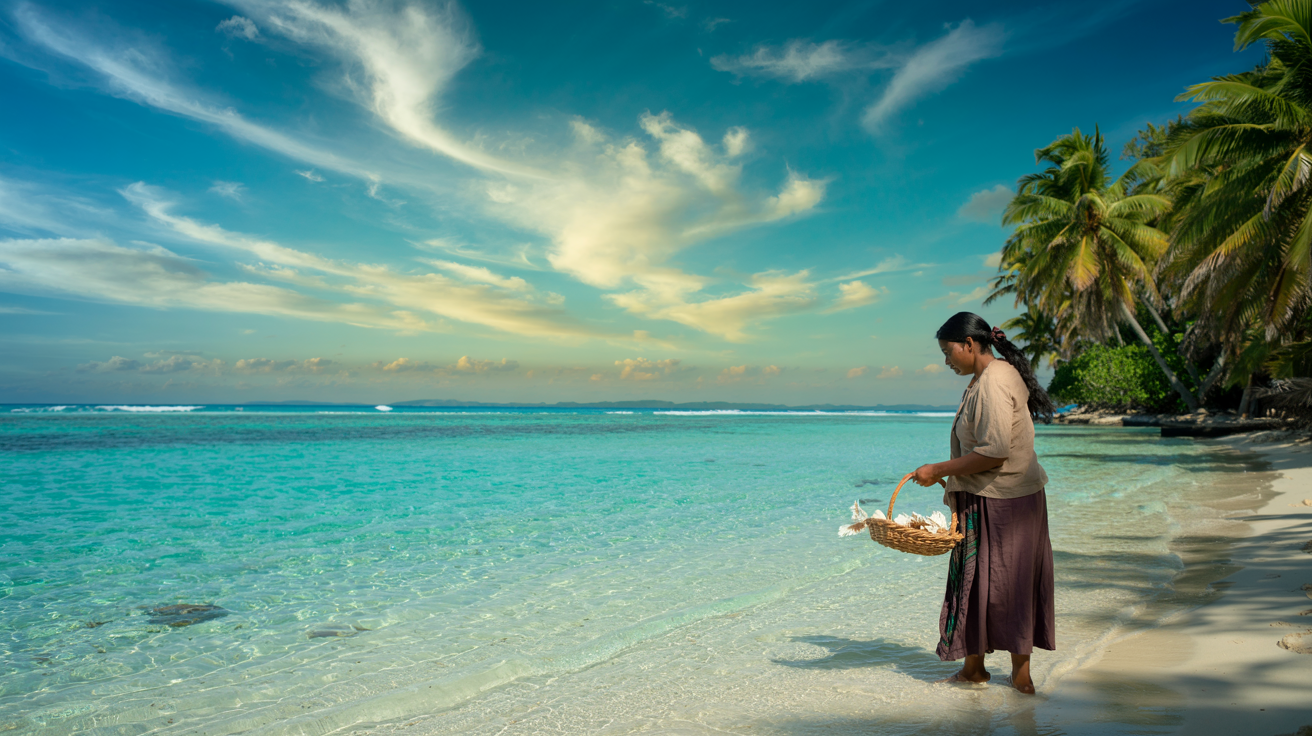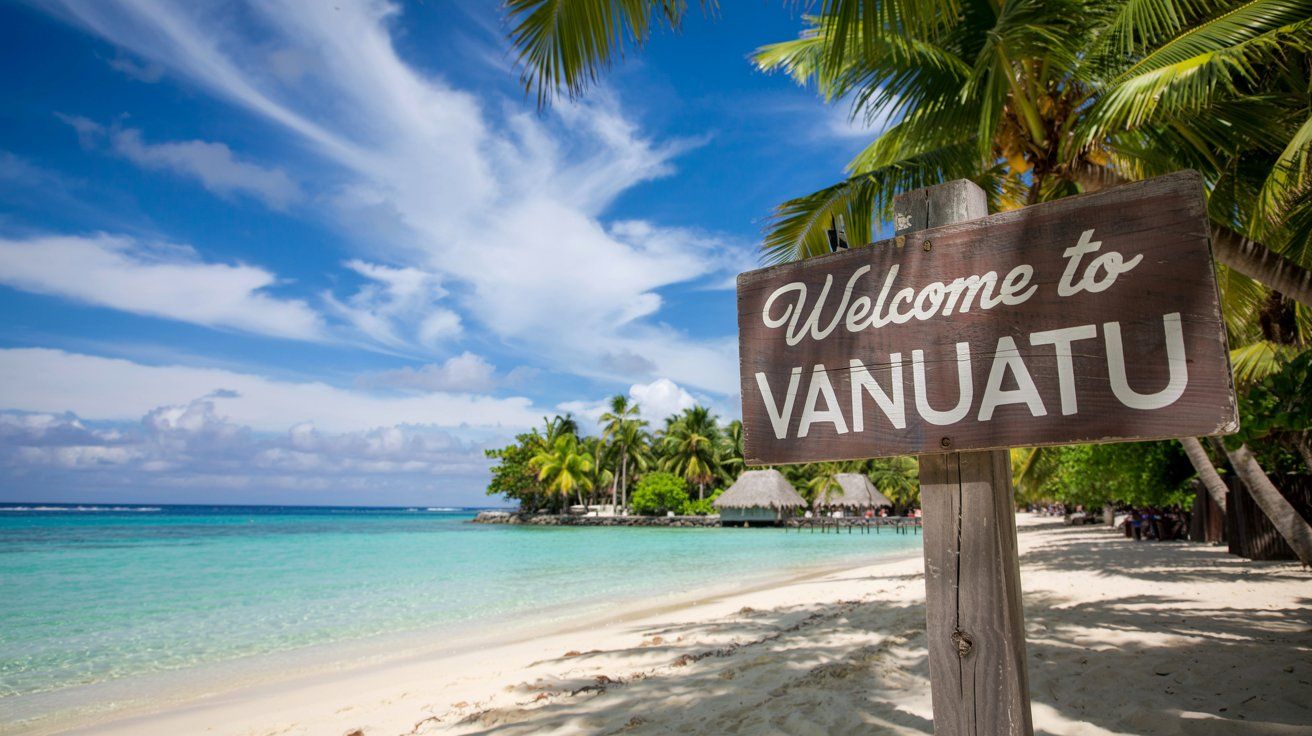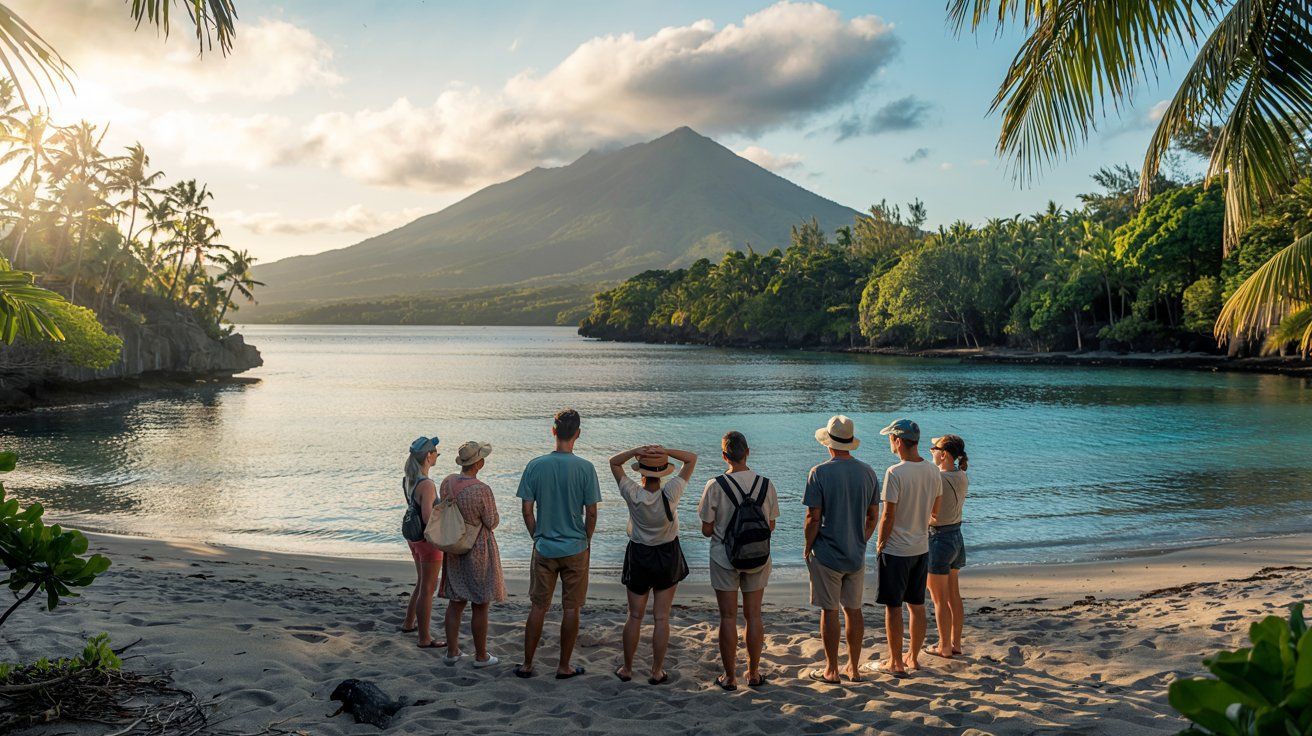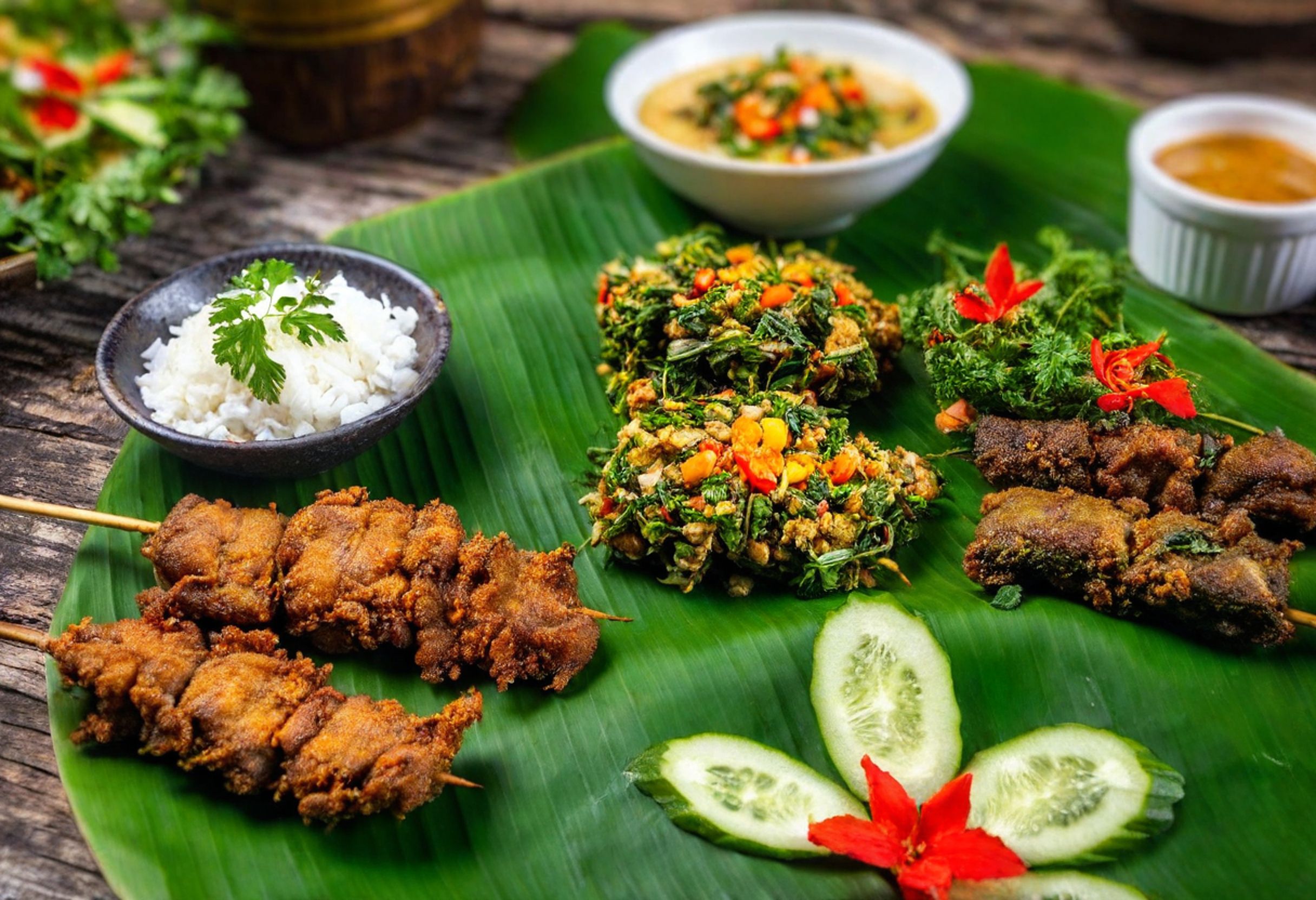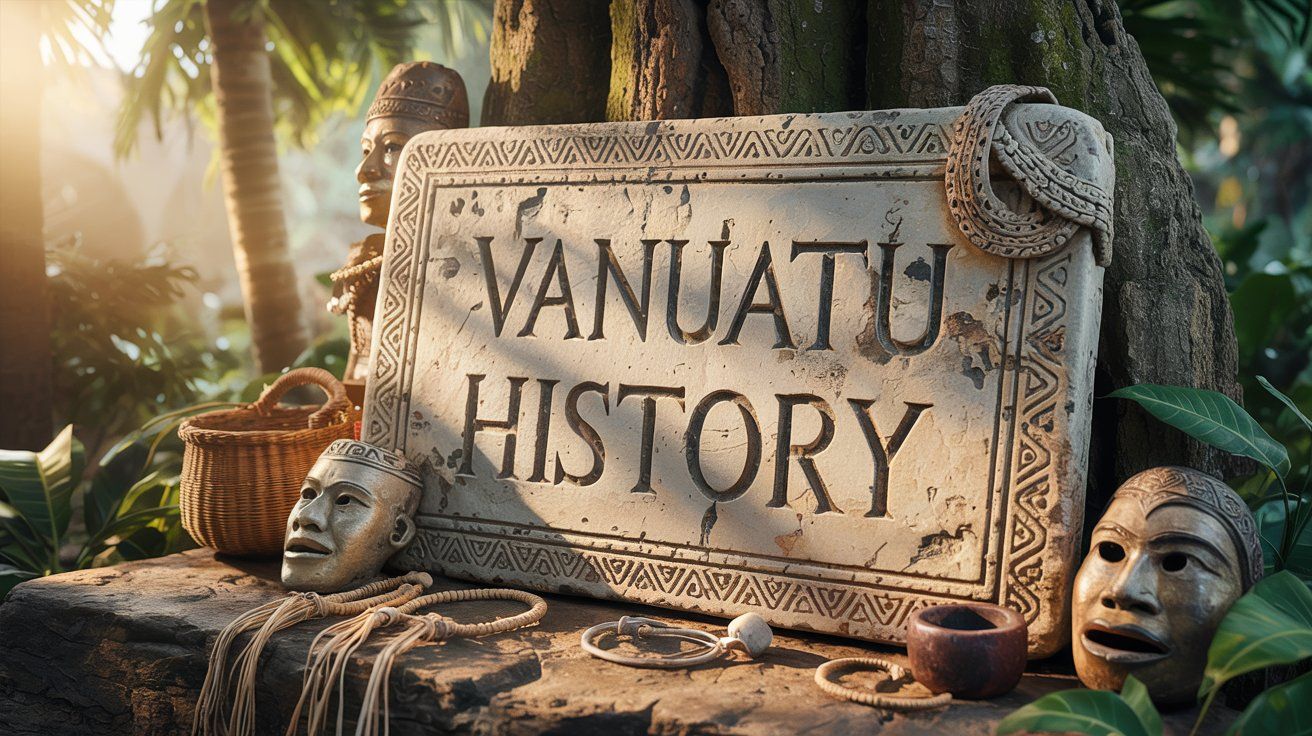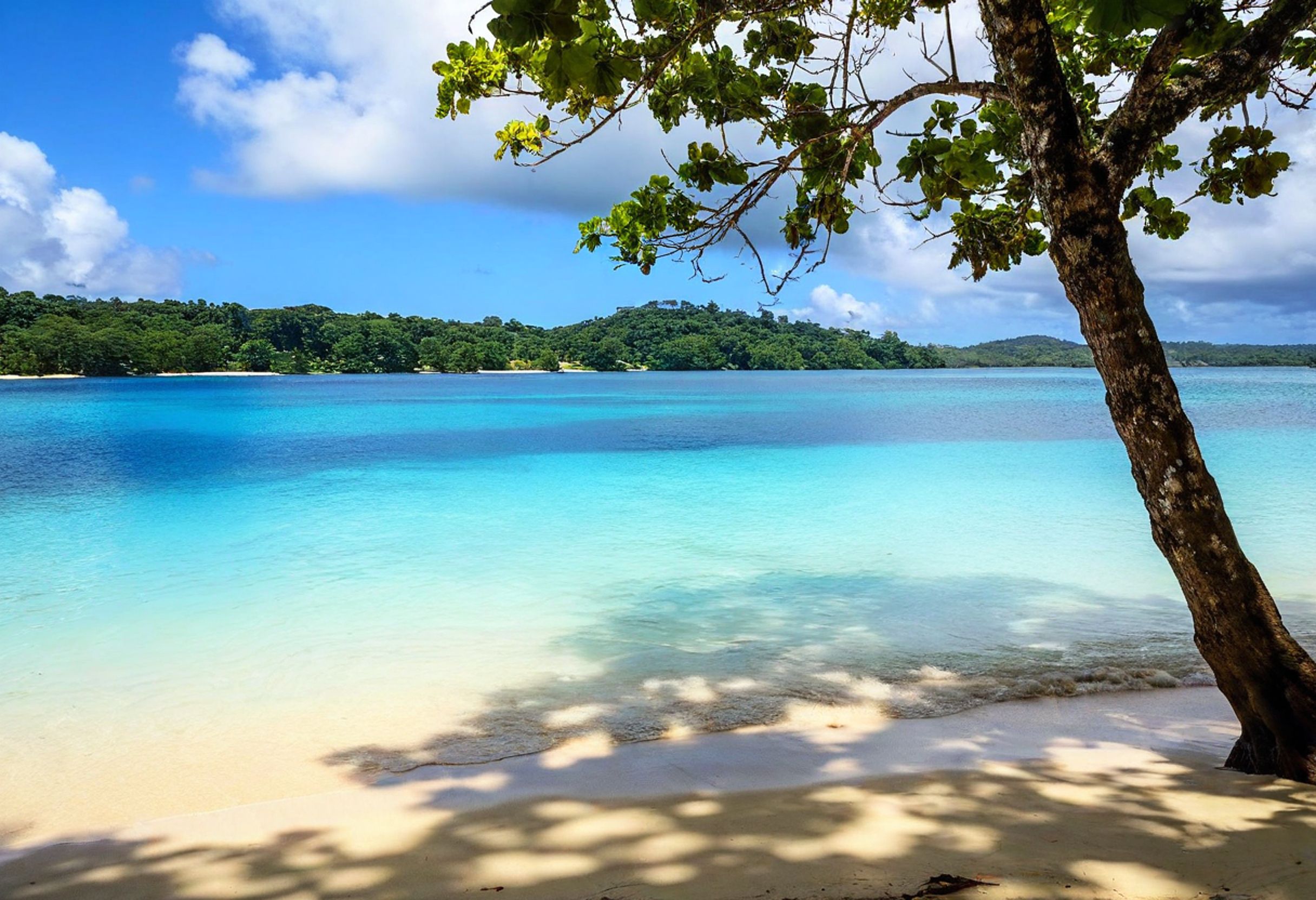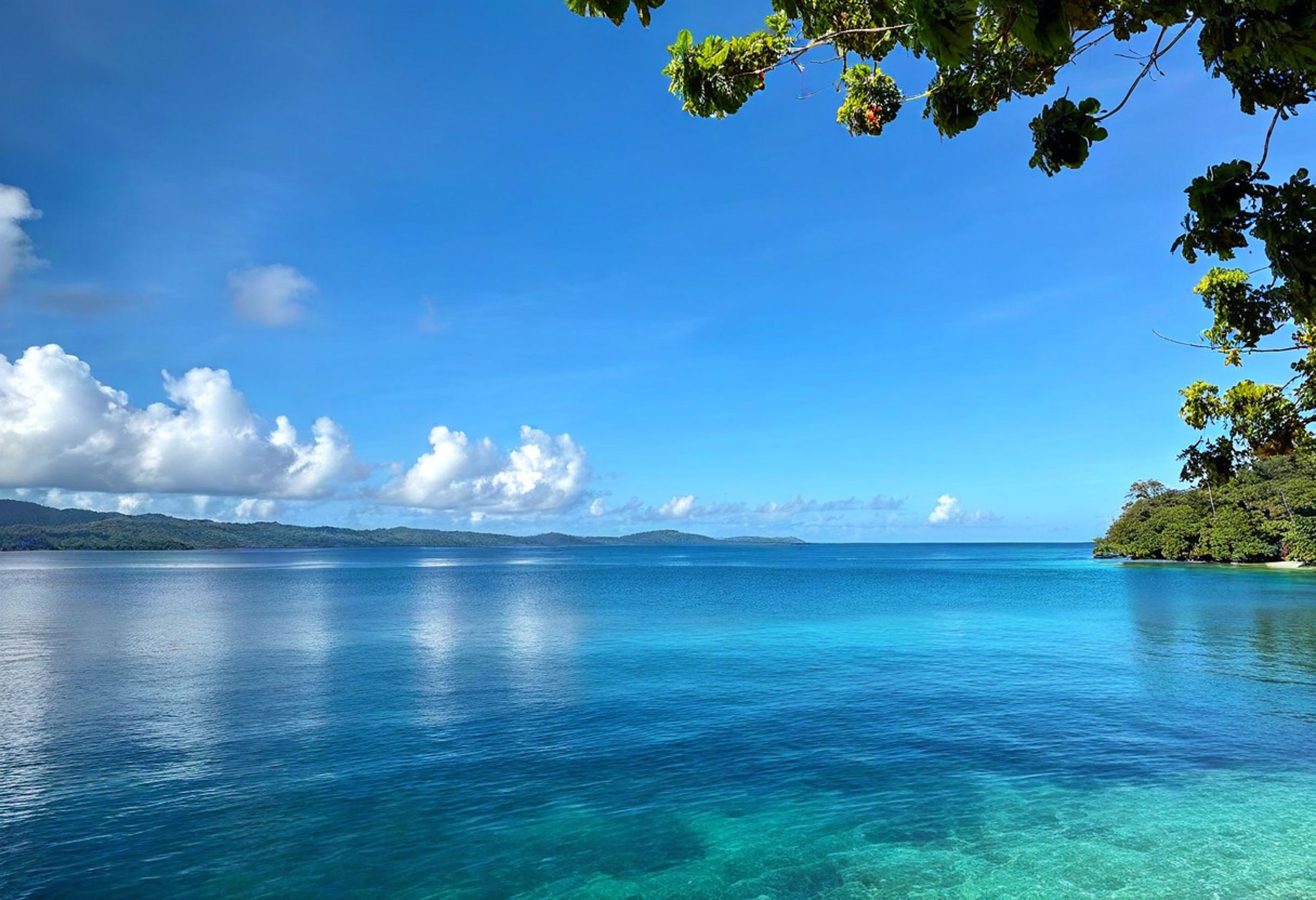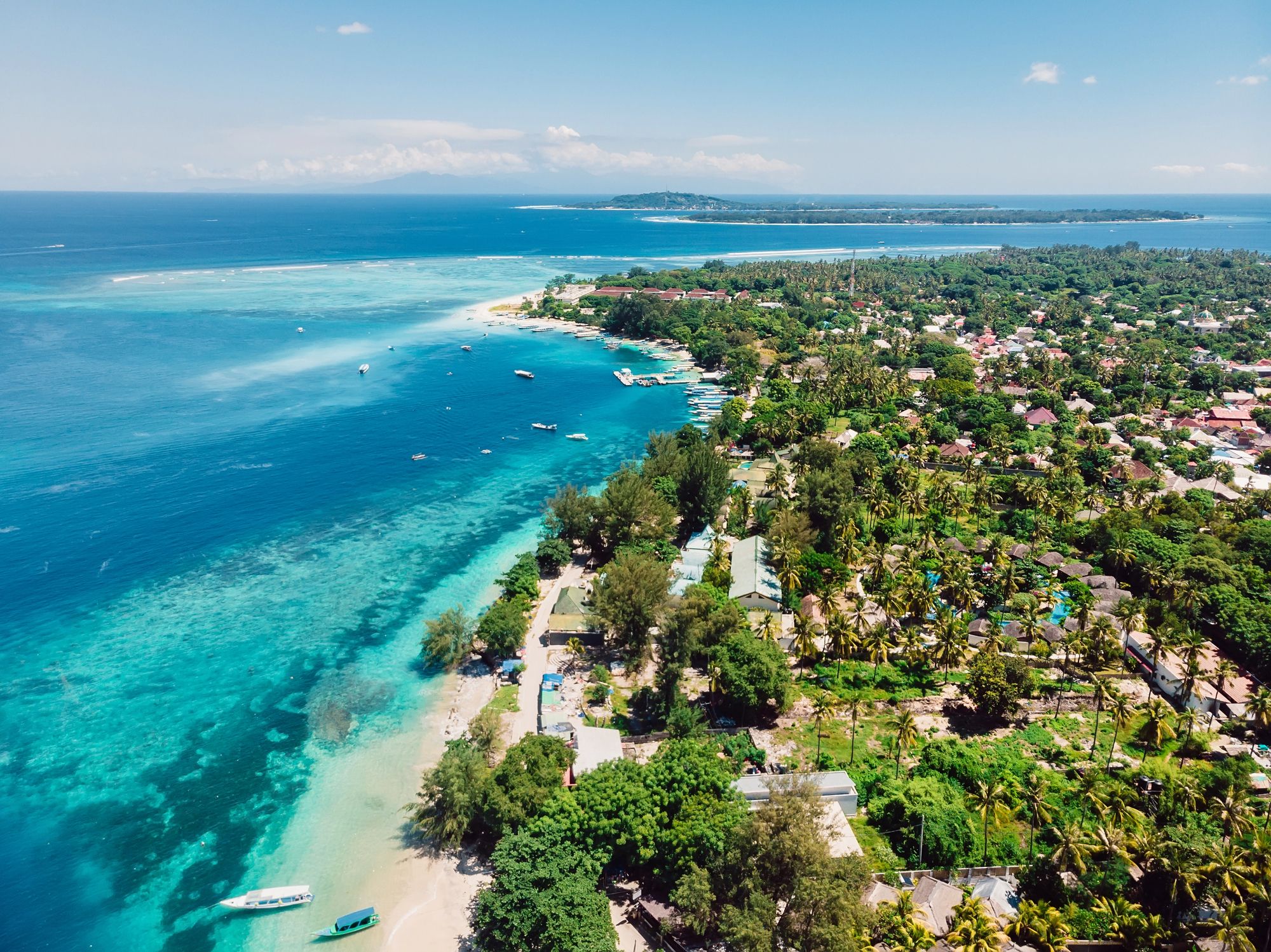Luganville sits on the southern coast of Espiritu Santo, Vanuatu’s biggest island. Locals call it Santo or Kanal, and you’ll find about 16,000 people living here. The city mixes laid-back island vibes with a surprising amount of history from its World War II days as an Allied base.
If you’re heading to Luganville, you can check out gorgeous coral reefs on glass-bottom boat tours, browse the lively waterfront market, or use the city as your springboard for island-hopping. Local tour operators run all sorts of water and land adventures that highlight the area’s natural beauty.
From overwater bungalows to beachfront resorts, find your perfect stay in this island nation of more than 80 islands. Instant booking with best price guarantee!
Browse Accommodations Now
Luganville feels less hectic than Port Vila but still bursts with authentic Vanuatu culture. The main boulevard hugs the waterfront, making it easy to wander between markets, restaurants, and attractions. It’s a great base if you want to explore Espiritu Santo at your own pace and soak up the relaxed South Pacific lifestyle.
Where Is Luganville?
You’ll find Luganville on the southern coast of Espiritu Santo island, right in the heart of Vanuatu—a Melanesian nation in the South Pacific. It’s the country’s second-biggest city and serves as a key port and gateway to the island’s top spots.
Geographical Overview
Luganville sits in the southwestern Pacific Ocean, within Melanesia. Vanuatu itself is a collection of about 83 islands stretching over 1,300 kilometers. The town rests on Espiritu Santo’s southern shore, in Sanma Province.
The city enjoys a tropical climate, so it’s warm year-round. Most of the shops and main facilities line the waterfront boulevard, facing out over the Segond Channel—a sheltered stretch of water separating Espiritu Santo from Aore Island.
As you walk around, you’ll notice the grid-like street pattern. American forces set that up during World War II when they built a base here.
Espiritu Santo Island Context
Espiritu Santo is Vanuatu’s largest island, covering around 3,955 square kilometers. Most folks just call it “Santo.” The island offers a mix of mountains, lush rainforest, and some truly stunning beaches.
Luganville acts as the main town and transport hub for Santo. The city changed a lot during World War II, when it hosted a major Allied base.
While Luganville takes up the southern tip of the island, much of Santo remains wild, with traditional villages scattered through the jungle. The island’s interior is thick with rainforest and crowned by Santo Peak (Tabwemasana), which rises to 1,879 meters.
Map and Accessibility
You can get to Luganville by plane or by sea. Santo-Pekoa International Airport (code: SON) sits about 2 kilometers from downtown. Regular flights connect to Port Vila, Vanuatu’s capital, in about 50 minutes.
Cruise ships use Luganville’s deep-water port at the main wharf, which links right to the town’s main street.
The main road (Canal Road) runs along the coastline. You’ll find it easy to get around, with:
- Taxis—always waiting at the airport and in town
- Rental cars—several agencies to choose from
- Local buses—unmarked vans that work as shared rides
Luganville is compact, so you can walk to most places from the center.
Why Visit Luganville
Luganville gives you a blend of cultural experiences, natural wonders, and adventure activities—all without the crowds you’ll find elsewhere in the Pacific. It’s a fantastic starting point if you want to experience the real Vanuatu.
Unique Melanesian Culture
Luganville is proud of its Melanesian roots. You’ll spot local markets where villagers sell fresh produce, crafts, and traditional foods. These markets are lively and give you a peek into daily life, plus a chance to chat with locals.
There’s a mix of influences here. Chinese-owned shops line the main street, showing the city’s multicultural history. Most folks speak Bislama (the national creole), but English is common, especially in tourist areas.
Traditional customs still matter a lot. If your timing’s right, you might catch ceremonial dances or kava-drinking rituals. Life moves at a slower pace here, so you can really connect with the culture in ways you might miss in bigger tourist hubs.
Natural Attractions
Luganville sits in the middle of Espiritu Santo’s natural beauty. The blue holes are a must—these deep, freshwater pools almost glow with a surreal blue.
Beaches near town offer soft white sand and great snorkeling. Champagne Beach, often named one of the world’s best, is a short trip from Luganville. Its powdery sand and clear water really do live up to the hype.
If you’re up for adventure, Millennium Cave is for you. The tour mixes hiking, cave swimming, and canyoning. The rainforests around Luganville are packed with unique plants and wildlife you won’t see anywhere else.
The coral reefs around the island are still mostly untouched, which makes them perfect for snorkeling and diving.
Adventure and Outdoor Activities
Diving is huge here. The SS President Coolidge wreck is famous among divers—this massive WWII transport ship is now an underwater museum you can explore, even if you’re not a pro.
If you prefer to stay dry, you can hike through jungle to waterfalls or join guided tours to remote villages. Local guides also offer kayaking trips along calm rivers and the coast.
Fishing is popular, whether you’re heading out to sea or just casting from shore. The waters around Santo are full of fish.
You can also try mountain biking or horseback riding, which are fun ways to see more of the island.
Most adventure activities here cost less than in other Pacific destinations, so it’s good value if you’re looking for something real and memorable.
How to Get to Luganville
Getting to Luganville, Vanuatu’s second-largest town, is easier than you might think, but you’ll want to plan ahead. You’ve got a few options, depending on your starting point and travel style.
Flights and Airlines
Air Vanuatu runs regular flights from Port Vila to Luganville’s Pekoa International Airport. The trip takes about 50-55 minutes and flights run several times a day. Lately, Air Vanuatu hasn’t been taking online bookings, so you’ll need to call to reserve your seat.
Keep in mind:
- Book a few days ahead, especially during busy seasons
- The planes are small for domestic flights
- Baggage limits are tighter than on international flights
- Weather can affect schedules
Flying is by far the fastest way if you’re coming from Port Vila or connecting from abroad.
Arrival via Sea
If you’re feeling adventurous, you can take a ferry. Two main companies run between Port Vila and Luganville:
- Vanuatu Ferry
- Big Sista
Both stop at several islands along the way, and the full trip takes about 24 hours.
Taking the ferry lets you see multiple islands and get a taste of local life. Just be ready for basic accommodations and a long ride. Still, the coastal views are lovely, and it’s a more down-to-earth way to travel.
Getting Around Locally
Once you’re in Luganville, taxis are the easiest way to get around—especially if you want to avoid walking in the heat or need to get somewhere quickly.
Shared minibuses also run around town and are cheap, but they don’t stick to strict schedules.
If you want to explore more:
- Rent a car from local agencies
- Book tours with local operators for top attractions
- Rent a bike for short trips in town
Taxis don’t use meters, so agree on a fare before you hop in. If you’re planning a day of sightseeing, hiring a driver for the day can work out better than paying for lots of short trips.
Top Things to Do in Luganville
Luganville packs in a surprising variety of natural and historic spots. The area is famous for its clear waters, unique landscapes, and amazing fishing.
Scuba Diving and Underwater Adventures
Luganville is a diver’s dream, whether you’re just starting out or have plenty of experience. Million Dollar Point is the most famous site—after World War II, the U.S. military dumped tons of equipment here. Now, you can dive among jeeps, bulldozers, and other gear, all covered in coral.
If wreck diving is your thing, don’t miss the SS President Coolidge. This luxury liner-turned-troop ship sank in 1942 and now sits at a depth that’s accessible to many divers. The wreck is huge, so you’ll need more than one dive to see it all.
Local dive shops offer certification courses and guided tours, and they’ll set you up with all the gear you need. Water visibility is usually excellent, and temperatures hover between 75-84°F (24-29°C).
Visiting Champagne Beach
Champagne Beach is often called one of the South Pacific’s most beautiful beaches. You’ll notice bubbles rising through the sand at low tide, giving the water a sparkling, champagne-like look.
The white sand and turquoise water are picture-perfect. The beach curves in a neat half-moon, and the calm waters are great for swimming and snorkeling.
It’s best to visit in the morning, before cruise ship crowds show up. Bring cash for the small entrance fee, which goes to local villagers who look after the beach. There are changing rooms and a few vendors selling coconuts and crafts.
Fishing Experiences
Fishing in Luganville is a blast, whether you’re after mahi-mahi, wahoo, tuna, or even marlin. Several charter companies operate from the harbor, offering trips that last half a day or longer.
Local guides know the best spots and provide gear. The best time for sport fishing is October to April, when migratory fish are more common. Shore fishing and spearfishing are also popular.
If you want something truly local, try joining village fishermen and learn about traditional, sustainable fishing. It’s a cool way to see how things have been done for generations.
Elegant resorts, tropical villas, and vacation rentals with immediate confirmation. Experience a culture dating back to 1,300 BC in this breathtaking archipelago!
See Available Properties
Catch-and-release is encouraged for some species to help keep fish stocks healthy. Some resorts will even cook your catch for dinner.
Exploring Blue Holes
Vanuatu’s blue holes are deep, crystal-clear freshwater springs. Nanda Blue Hole (also called Jackie’s Blue Hole) is the easiest to reach from Luganville—about 20 minutes by car.
The wild blue color comes from minerals and depth. The water stays cool year-round, making for a refreshing swim in these natural pools. Wooden decks make it easy to get in and out.
Matevulu Blue Hole is another favorite, especially for its rope swing. The tropical gardens around it are a nice spot to relax after a swim.
Bring water shoes if you have them, and a waterproof camera—the colors are unreal. Some blue holes charge a small fee that goes to local communities. Try to go early in the day for fewer people and the best light for photos.
Cultural Experiences
Luganville gives you real opportunities to connect with Vanuatu’s rich heritage. The culture here blends ancient Melanesian traditions with modern influences, so you’ll find experiences you just can’t get elsewhere in the Pacific.
Local Markets
Luganville’s bustling markets give you a real glimpse into daily life here. The main market runs from Monday through Saturday, but if you want to catch the real action, go on Friday or Saturday mornings—it’s packed and buzzing.
Colorful stalls overflow with fresh tropical fruits, veggies, and seafood. Friendly local vendors run the show, and you’ll spot island favorites like lap lap (root veggie pudding) and tuluk (banana leaf-wrapped meat). The vibe feels lively and welcoming.
Beyond food, keep an eye out for handmade crafts—woven baskets, carved wooden figures, and traditional jewelry. These make great souvenirs, and you’ll support local artisans at the same time.
If you can, get there early (around 6-8am). The produce is at its best and the heat hasn’t kicked in yet. Bring small bills and coins since vendors rarely have change for big notes.
Melanesian Traditions
If you’re after an authentic cultural experience, the Leweton Cultural Experience really stands out in Espiritu Santo. This living museum brings traditions from Gaua and Mere Lava to life.
You’ll see women performing the famous water music, slapping the water’s surface to create mesmerizing rhythms. They’ve passed down this art for generations, and it’s honestly captivating.
You’ll also watch demonstrations of traditional dress, kava preparation, and customary dances. Local guides talk you through the meaning behind each tradition.
The setting feels intimate, so you can chat with community members and ask questions. People usually don’t mind photos, but it’s polite to ask first.
Festivals and Events
Planning your trip around local celebrations adds a whole new layer to your Vanuatu adventure. Independence Day (July 30) lights up the islands with flag-raising, traditional dances, and massive community feasts.
Sanma Provincial Day brings cultural competitions between villages—expect custom dances, traditional costumes, and sporting events that show off local talent.
If you miss the big festivals, don’t worry. Resorts often host cultural nights with fire dancing, tamtam drumming, and string bands. These nights make it easy to get a taste of local culture.
Church services, especially on Sunday mornings, offer another window into Vanuatu’s culture. Christianity mixes with traditional beliefs, and you’ll hear some beautiful harmonized singing if you drop in.
Nature and Outdoor Activities
Luganville makes a fantastic base for exploring Vanuatu’s natural beauty. The area packs in all sorts of adventures, from caves and beaches to lush jungle trails.
Caving Adventures
If you’re up for a challenge, the Millennium Cave is Luganville’s top caving adventure. You’ll hike, scramble through caves, and swim through canyons deep in Espiritu Santo’s wild interior.
Local tour operators handle the logistics, providing guides, safety gear, and rides from town. You’ll pass through villages before descending into the vast cave system.
Inside, you’ll see stalactites and stalagmites that have formed over thousands of years. The adventure ends with a refreshing swim through canyons surrounded by towering rock walls.
If that sounds a bit intense, check out Mavunlap Cave tours. They’re shorter and less strenuous but still show off some amazing underground scenery.
Sandy Beaches Beyond Champagne Beach
Everyone talks about Champagne Beach, but honestly, Luganville hides plenty of equally gorgeous, less crowded beaches.
Port Olry Beach stretches over a kilometer with powdery white sand and clear blue water. Local beachside bungalows serve up fresh seafood, and you can rent snorkeling gear to explore the reef.
Lonnoc Beach is perfect for swimming, especially with kids—the bay stays calm and safe.
For real solitude, hop on a boat to Paradise Beach on the east coast. Hardly anyone goes there, so you might have the whole stretch to yourself. Snorkeling is fantastic too.
Hiking and Eco-Tours
Guided hikes to Mount Hope Waterfall take you through Espiritu Santo’s lush ecosystems. After about 45 minutes, you’ll reach a multi-tiered waterfall and a natural swimming pool—a sweet reward for the effort.
Jungle treks in the Vatthe Conservation Area are great for birdwatching and learning about medicinal plants. Local guides share stories about how people use jungle resources and explain conservation work.
If you’re a serious hiker, the trek to Mount Tabwemasana is the real deal. At 1,879 meters, it’s Vanuatu’s tallest peak, and the views are nothing short of epic.
Kayaking on the Sarakata River combines paddling with wildlife spotting. The mangroves teem with birds, and you might even spot a dugong if you’re lucky.
Where to Stay in Luganville
Luganville offers a range of places to stay for all budgets and tastes. You’ll find everything from simple guesthouses to comfortable resorts—plenty of options for your Espiritu Santo trip.
Bungalows and Local Guesthouses
A lot of travelers go for bungalows or local guesthouses to get a real feel for Vanuatu. These spots usually cost $30-60 per night, so they’re wallet-friendly.
Tropicana Motel offers basic, clean rooms at fair prices. It’s right in the center of Luganville, so you can walk to just about everything.
Most guesthouses have shared kitchens, letting you cook your own meals and save some cash.
Family-run places give you the chance to connect with locals and get insider tips. Hosts often share advice about hidden gems you won’t find in guidebooks.
Bungalows typically blend traditional design with modern comforts—think fans, mosquito nets, and sometimes ocean or garden views.
Resorts and Hotels
If you want more amenities, Luganville has a few solid resorts and hotels. Village de Santo Resort and The Espiritu are both popular picks.
Beachfront Resort sits right by the water. You can literally roll out of bed and into the ocean. Rooms usually go for $100-150 a night.
Most resorts offer:
- On-site restaurants and bars
- Wi-Fi (though it can be patchy)
- Help with booking tours
- Airport transfers
The Espiritu has comfy rooms with air con and private bathrooms. Their team can organize diving trips if you’re keen to explore Santo’s famous wrecks.
Bigger hotels sometimes bundle meals and activities into packages, which can save you a bit of hassle—and maybe some money.
Unique Accommodation Options
Luganville also has some quirky and memorable places to stay. These spots add a bit of personality to your trip.
You’ll find overwater bungalows at a few properties, giving you stunning views and direct access to the sea.
Some places are built around WWII relics, so history buffs can actually sleep in renovated military buildings—pretty cool, right?
Eco-lodges run on solar power, collect rainwater, and use local materials. They usually organize nature walks and cultural demos too.
Farm stays let you experience rural Vanuatu life. You might help pick fruit or learn to cook local dishes with your hosts.
Easy booking across stunning accommodations from luxury resorts to eco-friendly retreats. This Y-shaped archipelago offers pristine beaches, active volcanoes, and world-class diving!
Secure Your South Pacific Getaway
For longer visits or families, vacation rentals give you a kitchen and more space to spread out.
Dining and Local Cuisine
Luganville mixes traditional Vanuatu flavors with international food, so you’ll have plenty of places to eat during your stay.
Popular Restaurants
Restaurant le Jardin des Saveurs is probably the fanciest spot in town, serving up excellent French dishes for breakfast, lunch, and dinner.
Natangora Café has a laid-back vibe and a menu that swings between local and Western favorites. Their seafood is a hit with travelers.
Island Time Bar & Grill sits right on the water, perfect for a relaxed meal with a view. They focus on grilled meats and fresh fish.
Most dinner entrees cost 800 to 1600 vatu ($7-14 USD), and mains usually run 1800 to 2600 vatu ($16-23 USD).
Traditional Dishes
Lap lap, the national dish, is made from grated root veggies (like yam or taro), wrapped in banana leaves, and baked in an earth oven. You’ll find it in many local spots.
Tuluk is lap lap stuffed with island cabbage and meat, then wrapped up and steamed. It’s a tasty street food you can grab from vendors.
Coconut crab is a local delicacy, often cooked in coconut cream. It’s pricey and sometimes hard to find due to conservation, but worth a try if you spot it.
Other local eats include:
- Simboro (grated cassava in island cabbage)
- Nalot (pudding made from breadfruit or taro)
- Flying fox (fruit bat) in some rural places
Markets and Street Food
The Luganville Main Market is a buzzing spot to try local snacks and fresh fruit. It runs daily from early morning to mid-afternoon, but mornings are best for the freshest picks.
Street vendors offer quick bites like coconut bread, smoothies, and grilled fish skewers—usually 100-300 vatu ($1-3 USD).
Head out to Port Olry for beachside seafood barbecues. Local families set up simple restaurants right on the sand, serving the day’s catch with rice and veggies.
If you time your visit with a community festival, you’ll get to try special dishes and watch traditional cooking demos.
Essential Travel Information
Before you visit Luganville, Vanuatu’s second-biggest town, it’s good to know a few basics to make your stay on Espiritu Santo smooth and fun.
Weather and Best Time to Visit
Luganville has a tropical climate, with temps ranging from 68°F to 84°F (20-29°C) all year. The dry season (May to October) is the sweet spot for exploring.
The wet season (November to April) brings more humidity and the chance of cyclones, especially from January to March. Some activities might be off-limits and roads can get rough during this time.
April and October are great shoulder months—fewer crowds, good weather, and cheaper places to stay. You’ll enjoy the beaches, diving, and culture without feeling rushed.
Divers get the best visibility in the dry season, when the water is calm and clear.
Health and Safety Tips
Luganville feels safe, but keep an eye on your stuff in public. Healthcare is basic, so pack a good first-aid kit with:
- Your prescriptions
- Anti-diarrheal meds
- Motion sickness pills
- Insect repellent (30% DEET or higher)
- Sunscreen (SPF 30+)
Tap water is usually fine to drink, but bottled water is easy to find. After storms or cyclones, stick to bottled water until you hear it’s safe.
Mosquito-borne illnesses exist here, so use repellent and wear long, light clothes at dawn and dusk. If you’re visiting in the wet season, ask your doctor about malaria prevention.
Dial 112 in emergencies.
Money and Currency
The Vanuatu vatu (VUV) is the local currency. Major resorts and some restaurants take cards, but you’ll need cash for markets, small shops, and taxis.
ATMs sit in Luganville’s center, but sometimes they run out of cash or the network goes down. It’s smart to withdraw money when you arrive and keep enough for a few days.
You can exchange currency at the airport or banks in town. Banks usually have better rates than hotels or shops.
Prices in Luganville are generally lower than in Port Vila. Plan for about 5,000-8,000 vatu daily (US$40-70) for mid-range stays, meals, and activities.
Tipping isn’t expected here, but if someone goes above and beyond, it’s always appreciated.
Language and Communication
Bislama, an English-based creole, is Vanuatu’s national language. People also speak English and French widely here. In Luganville, you’ll notice most folks working in tourism—especially in hotels and dive shops—speak pretty good English.
A few basic Bislama phrases you might want to pick up:
- “Halo” (Hello)
- “Tangkyu tumas” (Thank you very much)
- “Hamas?” (How much?)
- “Mi no save” (I don’t know)
Mobile coverage works well in Luganville town, but it gets patchy once you head out to rural spots. Digicel and TVL, the two main providers, sell prepaid SIM cards for about 1,000 vatu. You can grab one at the airport or in town.
Most places to stay have Wi-Fi, but honestly, it’s usually pretty slow. If you need to get online, a few internet cafés in town offer another option.
Exploring the Outer Islands
Vanuatu’s magic doesn’t stop at Luganville. The outer islands are full of surprises—think active volcanoes, secret waterfalls, and totally different vibes on each island.
Efate and Efate Island
Efate is where you’ll find Port Vila, the capital. Most international travelers land here first. The island mixes city life with plenty of natural beauty.
Port Vila buzzes with markets selling tropical fruit and handmade crafts. Restaurants serve everything from local specialties to international fare. The seafront? It’s a great spot for an evening stroll.
Beyond the city, Efate’s beaches are stunning, with clear water perfect for swimming. Hideaway Island is a favorite for snorkeling—you’ll spot colorful fish just offshore.
Villages around Efate often open their doors to visitors. Through cultural tours, you can get a glimpse into traditional customs. Some even include kava ceremonies or dance performances.
Getting around Efate is pretty straightforward. Regular buses and taxis run all over, and you can rent a car if you want to go at your own speed.
Tanna Island and Yasur Volcano
Tanna Island delivers one of Vanuatu’s wildest experiences: Mount Yasur. People call it the “world’s most accessible active volcano,” and for good reason.
You can walk right up to the rim and watch eruptions explode into the sky. The ground shakes under your feet while Yasur spits molten lava—especially dramatic after dark, when the red glow lights up the night.
But Tanna isn’t just about the volcano. Many communities here still follow kastom, or traditional ways. Some villages invite guests in for cultural exchanges, which can be pretty eye-opening.
The island also has black sand beaches and natural pools. If you’re lucky with the tides, you can swim into Blue Cave—a real hidden gem.
To get to Tanna, you’ll need a short flight from Port Vila. Once you arrive, 4WD vehicles handle the rough roads best.
Island Hopping Tours
Island hopping is the way to see Vanuatu’s many sides. Plenty of tour operators offer packages that bundle together several islands.
These tours usually sort out your transport, accommodation, and activities. Some lean into adventure—think hiking, snorkeling, volcano visits—while others focus on soaking up local cultures.
From Luganville, you can take day trips to smaller islands nearby. Malo Island is just a quick boat ride and is known for its awesome snorkeling.
If you’re planning a longer adventure, organized tours make the logistics a lot easier. Getting between islands isn’t always simple.
Water taxis link some islands, but for longer distances, flying is often fastest. Air Vanuatu runs regular flights between the main islands.
Keep in mind, each island is different. Some have resorts, others offer simple village stays. It’s worth packing with this in mind.
Planning Your Luganville Trip
It pays to plan ahead for your Luganville adventure. A little prep goes a long way to making the most of this laid-back Vanuatu town.
Vanuatu Tourism Office and Travel Resources
The Vanuatu Tourism Office is a solid starting point for info on Luganville. Their website lists local attractions, places to stay, and transport tips. You can even download free brochures about Espiritu Santo and Luganville.
Local experts put together the “Rocket Guide,” which covers everything from restaurants to hidden beaches around Luganville. You can buy the digital version online before you go.
Luganville’s weather stays tropical all year. Most people prefer the dry season (May-October), when it’s around 75-85°F. The wet season (November-April) brings more rain, but you’ll see fewer tourists.
The Vanuatu vatu (VUV) is the local currency. Bring some cash—ATMs can be unreliable, and lots of smaller businesses don’t take cards.
Recommended Tour Operators
A few tour operators really stand out:
- Santo Travel – Custom trips around Espiritu Santo
- Wrecks to Rainforest – Blends diving and inland adventures
- Freshwater Plantation Tours – Focuses on cultural and historical experiences
If you’re keen to dive the famous SS President Coolidge wreck, check out Allan Power Dive Tours or Absolute Adventures. Both have great safety reputations and friendly local guides.
When you hire a taxi for sightseeing, try to agree on a day rate instead of paying per ride. It usually works out cheaper and means your driver sticks with you for the day.
Useful Links and Guides
Wanderlog’s web and mobile app makes it way easier to organize your Luganville itinerary. You can stash flight info, hotel bookings, and plan out your days all in one spot. Honestly, it saves a lot of hassle.
Wikivoyage has a travel guide packed with free, up-to-date info about Luganville—think transportation details and some handy etiquette tips. It’s worth a look if you want the basics without digging around.
If you’re coming in on a cruise, Princess Cruises actually arranges shore excursions for you. These tours usually hit blue holes, local villages, and WWII sites, so you get a lot out of your short visit.
Find available hotels and vacation homes instantly. No fees, best rates guaranteed!
Check Availability Now
Try joining online groups like the “Vanuatu Travel Planning” Facebook group. Folks there have just been and can share what’s currently good or warn you about anything to skip.
Oh, and definitely grab some offline maps before you go. Internet on Espiritu Santo island can be pretty unreliable, so having maps saved can save you from getting lost.

